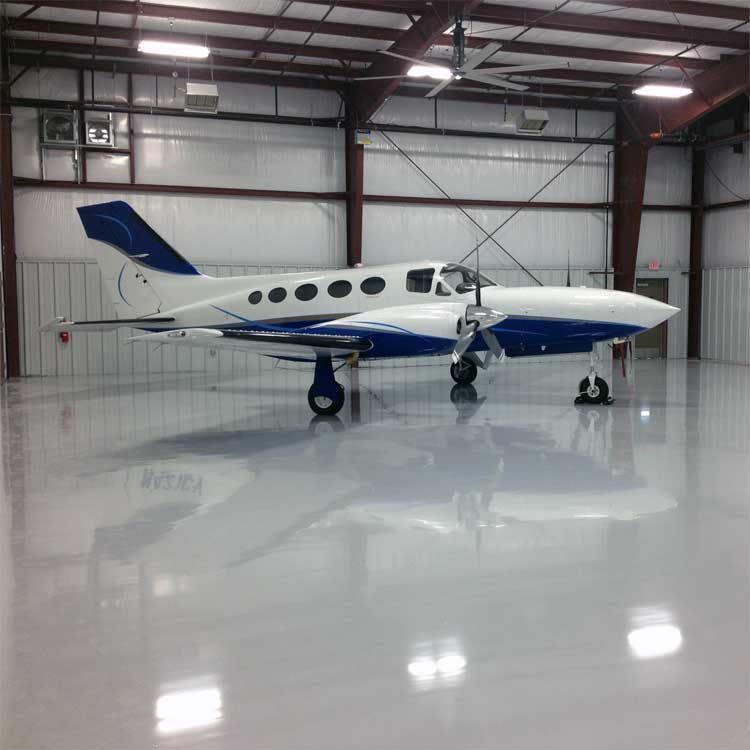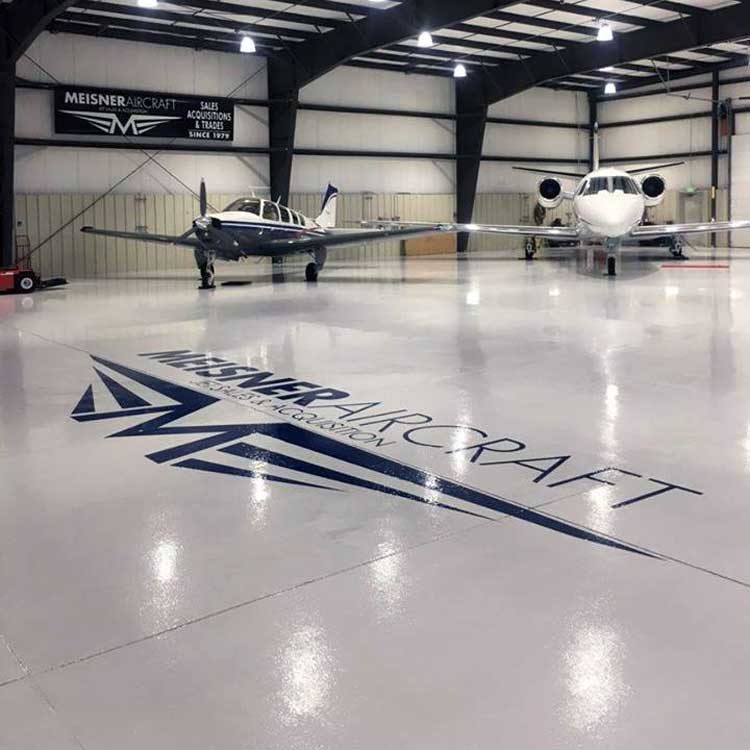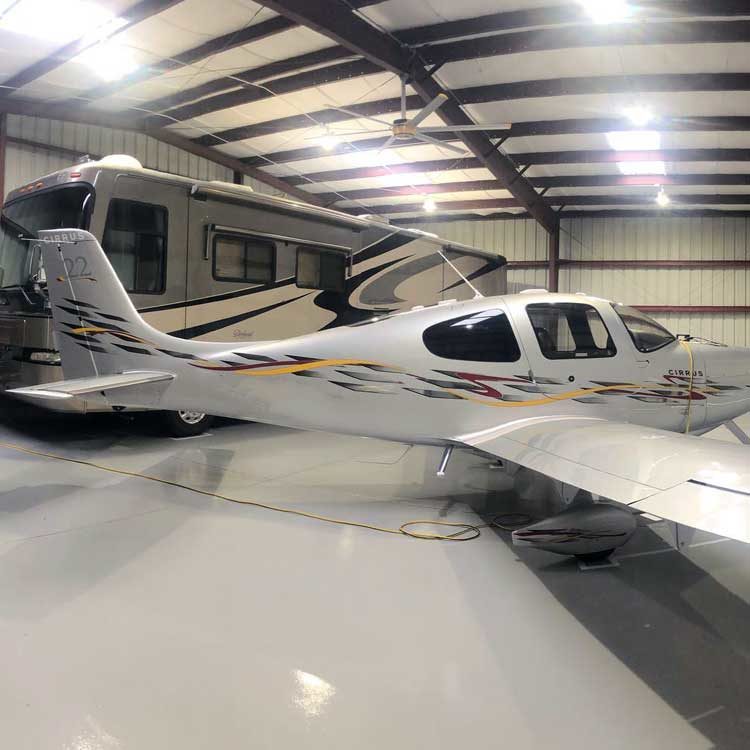Aircraft HangarS
HERMETIC™ Aircraft Flooring Systems are high performance, self-leveling, resinous coatings engineered for aircraft hangars and specialty aerospace floors. Our high build systems are a minimum of 45 mils thick, offering impact protection and increasing the strength of the concrete substrate, while being easy to maintain. The flooring system provides exceptional resistance to abrasion and chemicals common in such environments including Skydrol fluids and other petrochemicals. The finishes are anti-slip and come in light, reflective gloss or satin, and are UV stable.
Advantages
- Ease of maintenance
- Aesthetic improvements including custom logos and striping
- Increases the strength of the substrate
- High build, minimum of 45 mils
- Impact and abrasion resistant
- Light, reflective gloss or satin finishes
- Optional UV stability
- VOC free – CA 01350 air quality compliant
- Stain and chemical resistant (including Skydrol fluids and petrochemicals)
- Variable degree of slip resistance depending on requirements
- “Fast Set” curing agent available for quick turnaround time
Resources
- Name: HERMETIC ™ Aircraft Floor
- Finish: Gloss or satin
- Cured Thickness: @ 45 to 90 mils
- Surface preparation and detailed application instructions available on request
- Manufacturer: Elite Crete Systems, +1-219-465-7671
- HERMETIC™ Neat N20-224 – Specification | PDF Document
- HERMETIC™ Neat N35-357 – Specification | PDF Document
- HERMETIC™ Neat PT3-338 – Specification | PDF Document
- HERMETIC™ Stout DSF-486 – Specification | PDF Document
- HERMETIC™ Stout DSS-742 – Specification | PDF Document
- HERMETIC™ Stout SSF-334 – Specification | PDF Document
- HERMETIC™ Stout SSS-476 – Specification | PDF Document
- HERMETIC™ Paramount HD PHD-621 – Specification | PDF Document
- HERMETIC™ Paramount PAR-620 – Specification | PDF Document
Additional Specification are available for systems not typically recommended for aircraft floors.
- HERMETIC™ Aircraft Flooring System – Technical Brochure | PDF Document
- HERMETIC™ Neat Flooring System – Technical Brochure | PDF Document
- HERMETIC™ Stout Flooring System – Technical Brochure | PDF Document
- HERMETIC™ Paramount HD Flooring System – Technical Brochure | PDF Document
- HERMETIC™ Paramount Flooring System – Technical Brochure | PDF Document
Why Epoxy Floors Are Ideal for Aircraft Hangars
Aircraft hangars are specialized facilities designed to house and maintain aircraft, which means they require robust, durable, and practical flooring solutions that can withstand heavy-duty use. Among the various flooring options available, epoxy floors have gained immense popularity for hangars. Here’s why epoxy floors are an ideal choice for aircraft hangars:
- Durability and Strength
Epoxy flooring is known for its exceptional durability. Aircraft hangars are subject to heavy loads, including the weight of airplanes, ground support vehicles, and other equipment. The floor needs to withstand these intense pressures without cracking, chipping, or deteriorating. Epoxy coatings provide a tough, impact-resistant surface that can handle the weight of large planes and machinery.
Additionally, epoxy floors are highly resistant to abrasion from equipment, tires, and tools, ensuring they remain intact and smooth over the long term.
- Chemical Resistance
Hangars often deal with harsh chemicals such as aviation fuel, hydraulic fluids, solvents, and de-icing agents. These substances can easily damage or stain ordinary floors. Epoxy floors, however, are highly resistant to chemical corrosion and can withstand exposure to these substances without degrading. This makes them an ideal solution for the unique chemical environment found in aircraft hangars, ensuring longevity and reduced maintenance costs.
- Easy Maintenance and Cleaning
The smooth, seamless surface of epoxy floors makes them incredibly easy to clean and maintain. In a busy hangar environment, spills, oil leaks, and debris are common. Traditional flooring options with grout lines or seams can trap dirt and fluids, making cleaning a laborious task. Epoxy floors, on the other hand, can be quickly cleaned with minimal effort, improving the overall hygiene and safety of the workspace.
Additionally, epoxy floors are resistant to dust accumulation, which is essential in hangars where dust particles can compromise the functionality of aircraft components and mechanical systems.
- Slip Resistance and Safety
Aircraft hangars can become hazardous due to fuel spills or moisture accumulation. Epoxy flooring systems can be enhanced with slip-resistant additives, which provide a safer working environment for personnel. These floors can be customized to include textured finishes, offering added traction to prevent slips and falls in the hangar. This contributes to the overall safety of the facility and reduces the risk of accidents.
- Aesthetic Appeal and Customization
Epoxy flooring is available in a wide range of colors and finishes, allowing hangars to be customized to meet specific design and branding needs. Many hangars prefer a high-gloss finish for the epoxy, which not only gives the floor a polished, professional appearance but also helps reflect light, improving the visibility and brightness of the workspace.
Epoxy floors can also be marked with safety lines, zones, or custom logos, ensuring that the facility remains organized and safe for all workers. The visual clarity of these markings on an epoxy floor is superior to other flooring options, making it easier for personnel to navigate the space.
- Cost-Effectiveness
While the initial cost of installing epoxy flooring might seem higher compared to other alternatives, its long lifespan and minimal maintenance needs make it a cost-effective choice over time. Traditional floors may require frequent repairs or replacements due to wear and tear, but epoxy floors are built to last in demanding environments like aircraft hangars. The return on investment from reduced repair costs, lower maintenance, and fewer disruptions in operations makes epoxy a smart financial choice for long-term use.
- Fast Installation
In operational environments like aircraft hangars, downtime for flooring installation or repairs can disrupt workflows and lead to costly delays. Epoxy flooring systems can often be installed quickly and efficiently, allowing hangar operations to resume with minimal downtime. Additionally, epoxy floors can be cured quickly, enabling the facility to handle foot traffic, vehicles, and aircraft sooner than many other flooring types.
- Resistance to Extreme Temperatures
Aircraft hangars are often exposed to fluctuating temperatures, especially in locations with extreme weather conditions. Epoxy floors are designed to resist these temperature changes, providing thermal stability and preventing cracks or warping. This resilience is essential in maintaining a consistent, reliable floor surface, no matter the climate or external conditions.
Conclusion
Epoxy flooring offers a multitude of benefits that make it an ideal solution for aircraft hangars. Its durability, chemical resistance, ease of maintenance, and safety features make it perfect for handling the unique demands of a hangar environment. The ability to customize the floor’s appearance and safety markings, combined with its cost-effectiveness and fast installation, further solidifies epoxy’s position as the top choice for aviation facilities.
For hangar operators seeking a flooring solution that balances functionality, aesthetics, and durability, epoxy floors provide a superior option that will enhance operational efficiency while standing up to the wear and tear of daily aircraft maintenance and storage.
- Private hangars
- Military facilities
- Commercial airline hangars
- Aircraft maintenance bays
- Helipads
- Aerospace facilities
- SP.126 – HERMETIC™ Neat – Submittal Package | PDF Document
- SP.133 – HERMETIC™ Stout – Submittal Package | PDF Document
- SP.138 – HERMETIC™ Paramount – Submittal Package | PDF Document
- Resinous Industrial Coatings – Color Chart | PDF Document
- For custom colors refer to RAL




























